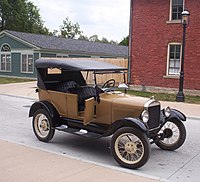
Photo from wikipedia
Abstract Motor performance patterns for mechanical assistance on unilateral force control can be affected by simultaneous muscle contraction. This study investigated how muscle activity and motor performance during the cooperation… Click to show full abstract
Abstract Motor performance patterns for mechanical assistance on unilateral force control can be affected by simultaneous muscle contraction. This study investigated how muscle activity and motor performance during the cooperation between dominant-arm force control and assistive force are affected by simultaneous non-dominant arm muscle contraction with inertial loading. Eleven participants (age: 24.1 ± 1.7 years) performed trajectory-tracking task based on visual feedback of real-time isometric force control. Their force for dominant-arm elbow flexion was released from reference magnitude of 47 N to magnitude of 23.5 N by providing mechanical assistance of a linear actuator. A 47 N of inertial loading on non-dominant arm elbow flexion was conditionally provided. For four time epochs of the experimental task, we measured responses of the assisted arm in terms of: (1) surface electromyography (EMG) amplitudes of biceps brachii and triceps brachii muscles, (2) peak perturbation, and (3) motor performance of force variability and target overshoot during manual force output. Simultaneous loading on unassisted arm did not affect peak perturbation of assisted arm. However, it caused lower force variability and overshoot ratio during the time epoch of force release and higher EMG amplitudes of biceps brachii muscle during the time epochs after mechanical assistance is provided, compared to the non-loaded condition. Our results indicate that simultaneous muscle contraction affects unilateral force control with mechanical assistance aimed at enhancing motor performance by creating extra agonist muscle activity. These findings can be utilized for improving the performance of human-robot cooperation during manual material handling in many industrial sites.
Journal Title: International Journal of Industrial Ergonomics
Year Published: 2020
Link to full text (if available)
Share on Social Media: Sign Up to like & get
recommendations!